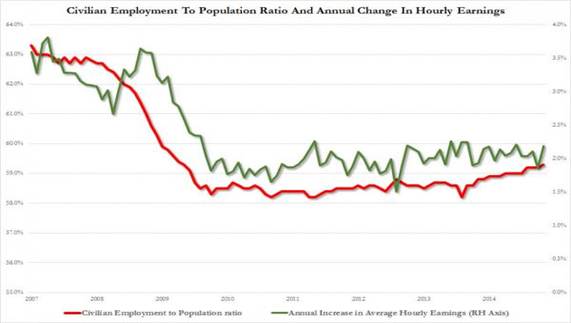The unemployment statistics provided by the U.S. Government are bogus… The devil is in the detail and a lot of people  don’t properly analyze the information they are being provided with. [Here is that detail which explains how those stats have been manipulated downwards to show a supposed unemployment rate of 5.7% rather than the true rate of 11.3%. Yes, 11.3%!]
don’t properly analyze the information they are being provided with. [Here is that detail which explains how those stats have been manipulated downwards to show a supposed unemployment rate of 5.7% rather than the true rate of 11.3%. Yes, 11.3%!]
By Gijsbert Groenewegen as originally posted* on gold-eagle.com under the title Deflation Of The Currencies And Eventually The US Dollar Will Boost The Ultimate Currencies, Gold And Silver To New Highs (Part 2) and with apparent liberal paraphrasing from an article** by Jim Clifton, Chairman and CEO at Gallup, (gallup.com) entitled The Big Lie: 5.6% Unemployment. Also check out an article*** by Michael Snyder (theeconomiccollapseblog.com) entitled Only 44 Percent Of U.S. Adults Are Employed For 30 Or More Hours Per Week for more insights into this topic.
Did you know, for example that:
- if you are so hopelessly out of work that you’ve stopped looking for a job over the past four weeks — the Department of Labor doesn’t count you as unemployed! While you are as unemployed as one can possibly be, and tragically may never find work again, you are not counted in the figure we see relentlessly in the news — currently 5.7%. Did you know this? Right now, as many as 30 million Americans are either out of work or severely underemployed.
- if you perform a minimum of one hour of work in a week and are paid at least $20 — maybe someone pays you to mow their lawn — you’re not officially counted as unemployed in the much-reported 5.7%! Did you know this?
- if, let’s say, you have a degree in chemistry or math and are working 10 hours part time because it is all you can find — in other words, you are severely underemployed — the government doesn’t count you in the 5.7%! Did you know this?
[Given the above,]… the official unemployment rate amounts to nothing more than a big lie!
On Friday, February 6, the BLS announced that in January:
- the U.S. created 257,000 jobs,
- companies began hiring at the fastest pace since 1997, with evidence emerging that a rapidly improving labor market might finally be triggering higher wage growth [see chart below],
- the unemployment rate [representing 8.69 million Americans] edged up to 5.7% from 5.6% because the healthier labor market drew more people into the labor force [only 44.2% of American adults are employed for 30 or more hours per week, according to Gallup],
- the number of people not in the labor force declined from 92,898,000 in December to 92,544,000 in January [for a sum total of 101 million that do not have a job right now] and that, as such,
- the labor force participation rate – the percentage of those in the civilian non-institutional population who participated in the labor force by either having a job or actively seeking one in the past four weeks – increased from 62.7% to 62.9%.
Although the January jobs report looked strong we shouldn’t forget that the labor market is often a lagging indicator. For example, when the U.S. entered recession in December 2007, 99,000 jobs were created (which was a seven-month high) but when the U.S. exited recession in June 2009, 502,000 jobs were lost. According to the January BLS report the number of Oil and Gas Extraction workers declined from 201.4K in December to 199.5K in January a drop of only 1,900 workers whilst according to third-party tracker Challenger, Gray & Christmas, the number amounted to 21,322 job cuts in January.
In order to put things into context and see what is really happening with the U.S. labor market we should look at the “improvement” of the level of the civilian employment to population ratio and the paltry annual increase in average hourly earnings.

This is what Hatzius Goldman Sachs said on CNBC on February 6: “The employment to population ratio is still 4% below where it was in 2006. You can explain 2% of that with the aging of the population that still leaves quite a lot of room potentially, and the wage numbers are telling us we are just not that close, although we are getting closer.” This can be confirmed by the fact that, for all the progress in the labor market, millions of Americans are still left out.
Some 18 million people who want a full-time job still can’t find one, including 6.8 million workers who have been forced to work part-time instead. If those people are taken into account, the nation’s unemployment rate is 11.3%. That’s still much higher than normal for an economy soon to enter its sixth year of expansion, underscoring the agonizingly slow pace of the recovery since the end of the Great Recession.
Conclusion
The government figures are a big sham! The real economic situation is much worse than the government – or Wall Street – want us to believe. Therefore, when the chicken comes home to roost the real situation comes to the surface the U.S. dollar will turn out NOT to be the safe haven investors thought they held. [Got gold?]
The article above is presented courtesy of Lorimer Wilson, editor of www.munKNEE.com (Your Key to Making Money!), and www.FinancialArticleSummariesToday.com (A site for sore eyes and inquisitive minds) and has been edited, abridged and/or reformatted (some sub-titles and bold/italics emphases) for the sake of clarity and brevity to ensure a fast and easy read. This paragraph must be included in any article re-posting to avoid copyright infringement.
Original Sources:
*http://www.gold-eagle.com/article/deflation-currencies-and-eventually-us-dollar-will-boost-ultimate-currencies-gold-and-silver (© Gijsbert Groenewegen);
**http://www.gallup.com/opinion/chairman/181469/big-lie-unemployment.aspx (Copyright © 2015 Gallup, Inc. All rights reserved.) ;
***http://theeconomiccollapseblog.com/archives/44-percent-u-s-adults-employed-30-hours-per-week
Follow the munKNEE!
Register for our Newsletter (sample here)
Find us on Facebook
Follow us on Twitter (#munknee)
Related Articles:
1. Is Current U.S. Employment Situation the New “Normal”? 6 Metrics Provide the Surprising Answer
This article answers the question as to how far the employment situation in the U.S. is from “normalizing” by analyzing 6 metrics to help answer the question. The conclusion is surprising. Read on. Read More »
 munKNEE.com Your Key to Making Money
munKNEE.com Your Key to Making Money


